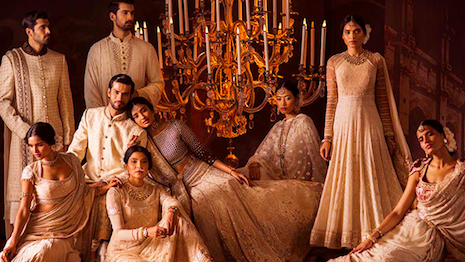- About
- Subscribe Now
- New York,
January 26, 2017

 Tarun Tahiliani is one of India's most storied luxury designer brands, known for its opulent ensembles and detailed craftsmanship. Image source: Tarun Tahiliani
Tarun Tahiliani is one of India's most storied luxury designer brands, known for its opulent ensembles and detailed craftsmanship. Image source: Tarun Tahiliani
By Abhay Gupta
Last year ended eventfully with upheavals across the globe: terror attacks in Europe and the Middle East, the Brexit fiasco in the United Kingdom, the unexpected presidential victory of Donald J. Trump in the United States and, last but not the least, the demonetization drive by India’s Prime Minister Narendra Modi, who Nov. 8 ordered the withdrawal of 500- and 1,000-rupee bills from circulation accounting for 86 percent of all cash in the country.
All these factors have had adverse or positive impacts on the luxury business. Indeed, the global luxury industry valued at 1 trillion euros in 2015 by Bain & Co. registered a mere 5 percent growth over 2014.
The global luxury market has now reached an era of single-digit growth.
Stellar returns
However, as the rest of the world stabilizes, the Indian growth story is hard to discount.
For most luxury brands, India has become the hottest marketplace.
Growing at approximately 25 percent on a compounded annual growth rate (CAGR), India is estimated to have reached $18.3 billion last year, up from $14.75 billion in 2015.
The single biggest factor contributing to this growth is the steep rise of the affluent class due to the stellar performance of the economy and the startup culture.
Estimates reveal that the number of high-net-worth (HNI) households have grown at a CAGR of 16 percent from 81,000 in 2011-12 to 146,600 in 2015-16. This is further expected to increase to 294,000, representing a total net with of $4.7 trillion, or 319 trillion rupees.
While there is tremendous buoyancy around affluent Indians and their luxury consumption, there are clearly a few misconceptions in the minds of the marketers. Here are 10:
1. The affluent Indian makes and spends money easily: This perhaps is the biggest misconception going around.
Making an Indian spend his money is a acid test for any brand.
India typically has two types of affluents: The “khandani raees” (traditional rich) and or the “New maharaja” (people who made money after India’s independence from the U.K. in 1947).
Both of them work long hours, forgo a lot of personal time, make sacrifices, undertake a lot more risk and add value to the society as compared to many others.
Hence, they are cautious spenders and research well before they splurge on luxury, only to seek the best.
The traditional rich, being generally well informed and highly knowledgeable, like to preserve their heritage and wealth handed over by previous generations.
The new maharaja, on the other hand, having made the entire wealth in his or her own lifetime, is a cautious, hardworking and extremely value-seeking customer. His or her erstwhile middle-class background makes him or her seek justification for every bit of expenditure.
Both seek respect for their time, recognition for their hard work, status and individuality. Do not take them for granted.
2. All Indian nouveau riche are conspicuously ostentatious spenders: While this may be true for a vast variety of customers visiting luxury stores, it is a grave mistake to generalize all the nouveau riche into logo-thirsty clientele.
The fact remains that many of the “valuation-business” (read ecommerce boom) super-rich generation have made quick money in the past few years.
Usually of highly technical background, the “backend” culture they belonged to never gave them any real need for all things fancy and expensive. They now wish to acquire style to suit their status, which is not necessarily loud and logo-driven. They are shy as well respectful towards others, and typically will experiment with brands, products and services.
Influenced by other user experiences rather than just pure sales talk in their decision-making process, they usually like to be subtle and elegant rather than loud and garish.
Treat them with respect for their human values and admiration for the success that they have achieved in a short span of time. Not many can duplicate what they have achieved in such a short period.
3. Most (new) Indian affluent consumers cannot define luxury nor recognize luxury brands: On the contrary, most of them are clear with their definition of luxury. To mistake their simplicity for ignorance can be a fatal mistake.
In a fast-emerging market such as India, these consumers may not recognize the brand and even get the brand name pronunciations wrong.
However, each one has his or her purchase motivations, which may run beyond the standard boardroom definition of luxury. They are fast learners and would like you to arrive at the value proposition of your brand quickly.
“Underestimate yourself and overestimate the other” can be a sure-shot success mantra. Inform, educate, guide and lead them to purchase.
4. Luxury is the sole prerogative of the affluent class: On the contrary, in a country such as India, luxury is a bigger pull for various other classes. These range from the HENRYs, the upper middle class and the returning non-resident Indian (NRI) to the first-time aspirant.
Luxury brands and services need to address and offer products that can draw in all such classes into their zone and create a much wider reach, recognition and goodwill for the brand.
India is a market with a majorly unexposed population – people with rich tastes and high cultural values seek all things good in life. Expand your horizon beyond the theory-book definition.
5. Indian affluents spend more on luxury goods than services: There can be no bigger misnomer than this.
While the initial spends are towards luxury goods such as watches, apparel, accessories and automobiles, followed by home and interior, the switch to services happens quickly.
The newly acquired status needs to be shared and appreciated by near and dear ones extending into a wider social circle.
Spending on beauty, fitness, entertainment, fine dining, concierge, travel and tourism quickly ramp up the expenditure chart.
Offer compelling experiences to them and their circle of friends to enable them to feel important in the eyes of their social network.
6. Indians do not shop luxury online: A generally tech-oriented nation thanks to the smartphone revolution, the India’s consumers have quickly leapfrogged into the digital space.
From books to cars to homes and now even yachts are being sold online.
Newer concepts such as pre-owned luxury and rent-a-luxury are adding new dimensions to luxury purchases, as well as new customers.
Be open to experimenting and adapt to a fast-evolving market.
7. Indian affluent consumers and luxury are restricted to metros: Contrary to popular belief, the Indian affluent base is spread across the entire country.
Luxury brands do face a challenge with respect to setting up physical stores in every location, but servicing this fragmented market may be the key to success.
The digital wave has yielded many new customers to luxury brands. They now order through various channels, ranging from WhatsApp to Facebook’s Messenger and trunk shows conducted by brands or event companies across the Indian subcontinent.
Think beyond the metropolitan areas. Reach out to, inform and educate affluent consumers beyond traditional markets.
8. Indian affluent consumers do not refer to consumer ratings: The sharing economy encourages one and all to share experiences, thoughts, opinions and post-purchase reactions.
Once again, a typically technologically inclined nation engages with unknown brands based not only on the views shared on the brand’s Web site, but also other user comments and reactions. This is particularly so in the service sector.
While word of mouth is the universal promoter for luxury goods and services, online referrals are equally important for a wider reach.
Be true to the customer by sharing genuine advice and information rather than exaggerated claims. The customer is in all probability pre-informed.
9. The Indian affluent consumer is not brand loyal: While most Indians are yet experimenting with luxury brands and services, the fact remains that, by basic nature, Indians are generally very loyal – to their wives as well as their brands.
Affluent consumers who have undergone the entire trial cycle swear by the brand with which they settle unless until they encounter some quality or service issue.
Deliver product and service value every time the customer shops with you. Do not take him or her for granted.
10. Demonetization of old 500- and 1,000 rupee bills will affect luxury consumption: Against popular belief, an informal survey with most brands across various luxury goods and services categories shows that the affluent customer base and the brands both have embraced the digital drive for money transfer very well. While the old currency has been swapped for new, the central government’s emphasis is on moving transactions to cashless, digital and credit card.
After an initial lull and slowdown, it is anticipated that business will be back to normal soon.
Luxury surely is recession-proof, unaffected by shocks in the economy or otherwise. Indian affluent consumers continue to enjoy their taste of all good things in life.
 Abhay Gupta is founder/CEO of Luxury Connect and Luxury Connect Business School
Abhay Gupta is founder/CEO of Luxury Connect and Luxury Connect Business School
Abhay Gupta is founder/CEO of Luxury Connect and Luxury Connect Business School, Gurgaon, Haryana, India. Reach him at abhay@luxuryconnect.in.
Share your thoughts. Click here